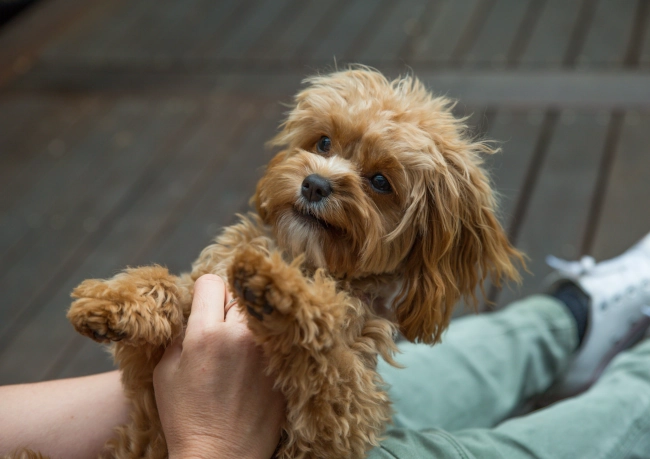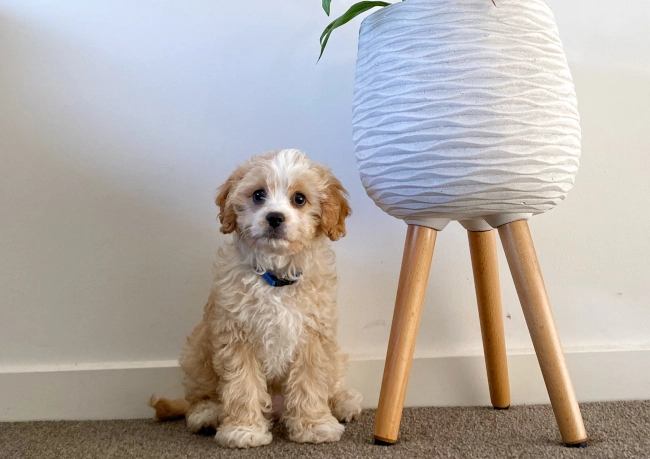Training A Cavapoo For Therapy Work

If you’re considering training a Cavapoo for therapy work, you’re in for a delightful and rewarding experience.
These endearing and intelligent crossbreeds, possess all the qualities needed to excel as therapy dogs.
From their gentle and loving nature to their high intelligence and adaptability, Cavapoos have the potential to bring immeasurable comfort and joy to individuals in need.
In this article, we will explore the key steps and techniques involved in training a Cavapoo for therapy work, providing you with valuable insights and practical advice to ensure a successful journey towards becoming a certified therapy team.
Choosing the Right Cavapoo for Therapy Work
When it comes to selecting a Cavapoo for therapy work, thorough research is essential.
We need to understand the breed’s characteristics, temperament, and health considerations to ensure we find the best-suited companion.
Cavapoos are a mix of Cavalier King Charles Spaniel and Poodle, known for their endearing personalities and intelligence.
However, each Cavapoo can have unique traits, so it’s crucial to work with reputable breeders who focus on producing dogs with the right disposition.
Researching the Breed
Start by researching the breed’s general characteristics and traits.
Cavapoos are typically friendly, affectionate, and adaptable, making them excellent candidates for therapy work.
They are known for their love of human companionship and their ability to provide comfort and support.
However, it’s important to remember that individual Cavapoos can vary in temperament, energy levels, and socialization needs.
Taking the time to familiarize ourselves with these aspects will help us make an informed decision.
Temperament Assessment
Before beginning therapy work, it’s crucial to assess a Cavapoo’s temperament.
This evaluation ensures that the dog has the right disposition to handle the demands and stresses of therapy work.
Temperament assessments can be done by professional trainers or behaviorists who specialize in evaluating therapy dogs.
They will look for traits such as confidence, calmness, and a willingness to engage with humans.
Health Evaluation
The health of a Cavapoo is of utmost importance when considering them for therapy work.
Regular vet check-ups, vaccinations, and screenings for potential genetic health conditions should be a priority.
It’s essential to work with reputable breeders who prioritize the health and well-being of their dogs.
A Cavapoo with good overall health and a clean bill of genetic health will be more resilient and able to provide consistent support in therapy settings.

Creating a Positive and Supportive Environment
To prepare a Cavapoo for therapy work, it’s important to create a positive and supportive environment in which they can thrive.
This involves creating a safe space, establishing a routine, and providing enrichment activities to keep their minds stimulated and engaged.
Creating a Safe Space
Designate a specific area in your home as the Cavapoo’s safe space.
This area should be comfortable, quiet, and free from any potential hazards.
Provide a cozy bed, toys, and a familiar scent, such as an item of clothing that carries your scent.
By having a designated safe space, your Cavapoo will have an opportunity to relax and recharge, ensuring they are emotionally prepared for therapy work.
Establishing a Routine
Cavapoos thrive on routine, as it provides them with a sense of security and structure.
Establish a consistent daily routine for feeding, exercise, playtime, and rest.
This regularity will help your Cavapoo feel more balanced and prepared for the demands of therapy work.
Remember to include adequate exercise and mental stimulation in their daily routine to keep them physically and mentally fit.
Enrichment Activities
Enrichment activities are essential for keeping a Cavapoo engaged and mentally stimulated.
Incorporate puzzle toys, treat-dispensing games, and interactive play sessions into your Cavapoo’s routine.
This will not only provide mental stimulation but also strengthen the bond between you and your dog.
Regular enrichment activities ensure a well-rounded and content Cavapoo, ready to provide therapy support to those in need.

Basic Obedience Training
To prepare a Cavapoo for therapy work, basic obedience training is essential.
Teaching them commands such as sit, stay, down, recall, and leave it establishes a solid foundation for their role as therapy dogs.
This training helps to ensure that they can follow instructions reliably and respond appropriately in various therapy settings.
Teaching Sit, Stay, and Down Commands
Begin with teaching your Cavapoo basic commands like sit, stay, and down.
These commands not only promote good behavior but also help establish clear communication between you and your dog.
Use positive reinforcement techniques such as treats, praise, and affection to reward their successful execution of these commands.
Remember to keep training sessions short, fun, and consistent to maintain their enthusiasm and focus.
Mastering Recall and Leave It
Recall and leave it commands are crucial for a Cavapoo’s safety and success as a therapy dog.
Teaching them to come when called and to ignore potential distractions helps maintain control and prevents any unwanted behaviors.
Gradually increase the level of distractions during training sessions to ensure they respond reliably in various environments.
Consistent practice and positive reinforcement will enable them to master these important commands.
Introduction to Leash Walking
Proper leash walking etiquette is needed for therapy work.
Introduce your Cavapoo to leash walking by using positive reinforcement techniques.
Start in a low-distraction environment and gradually increase the level of distractions as they become more comfortable.
Encourage loose leash walking by rewarding them for walking politely by your side.
Leash training will ensure your Cavapoo is well-behaved, enhancing their ability to provide therapy support in controlled settings.

Socialization and Exposure
Socialization and exposure are vital aspects of preparing a Cavapoo for therapy work.
Positive experiences with humans, interaction with other animals, and exposure to various environments help them develop confidence, adaptability, and a calm demeanor.
Positive Experiences with Humans
Expose your Cavapoo to a variety of people of different ages, appearances, and behaviors.
Encourage positive interactions with strangers, emphasizing gentle touch, calm behavior, and appropriate responses.
This exposure will help them feel comfortable and at ease when interacting with a wide range of individuals during therapy sessions.
Interaction with Other Animals
Provide opportunities for your Cavapoo to interact with other animals in controlled settings.
This can include supervised playdates with well-socialized dogs or visits to dog-friendly parks.
Socializing with other animals helps your dog learn appropriate behavior, build social skills, and develop confidence.
However, always prioritize safety and monitor their interactions.
Introducing Various Environments
Expose your Cavapoo to different environments and sensory stimuli they may encounter during therapy work.
Gradually introduce them to busy streets, various indoor settings, noises, and unfamiliar objects.
By gradually exposing them to new environments, you help them build resilience and adaptability.
Always prioritize their well-being and ensure they feel safe and supported during these exposure sessions.
Desensitization and Counterconditioning
Desensitization and counterconditioning are valuable techniques to address any fear or anxiety triggers your Cavapoo may experience.
These techniques help them develop a more positive association with previously fear-inducing stimuli and enable them to respond calmly in potentially stressful therapy situations.

Addressing Fear and Anxiety Triggers
Identify any specific triggers that may cause fear or anxiety in your Cavapoo.
Common triggers could include loud noises, crowds, or specific objects.
Once identified, gradually introduce these triggers in a controlled and positive manner, pairing them with something your Cavapoo finds enjoyable, such as treats or playtime.
Over time, this approach helps them overcome their fears and build confidence.
Gradual Exposure to Stimuli
Gradually expose your Cavapoo to stimuli that they may encounter during therapy work.
This could include simulated therapy scenarios, such as having strangers interact with them while undergoing training exercises.
Slowly increase the intensity and complexity of these scenarios while ensuring that your Cavapoo remains comfortable and relaxed.
Gradual exposure allows them to acclimate to potentially challenging situations, preparing them for therapy work.
Reward-Based Training Techniques
Utilize reward-based training techniques when desensitizing and counterconditioning your Cavapoo.
Positive reinforcement helps create a positive association with previously anxiety-inducing stimuli.
Rewards can include treats, praise, or playtime.
By focusing on rewarding desired behaviors, you strengthen their confidence, resilience, and positivity, aiding the success of their therapy work.
Advanced Training Exercises
To prepare a Cavapoo for therapy work, advanced training exercises are crucial.
These exercises help them navigate emergency situations, work through distractions, and perform task-specific training to cater to the needs of their future therapy recipients.
Emergency Situations and Commands
Teach your Cavapoo commands specifically designed for emergency situations.
This can include commands such as “drop it” or “go to your safe space.”
By conditioning them to respond calmly and obediently during unexpected events, you ensure their ability to assist and support during therapy sessions if the need arises.
Working Through Distractions
Ongoing training to help your Cavapoo maintain focus and work through distractions is essential for therapy work.
Gradually increase the level of distractions during training exercises, such as controlled noises, interruptions, or other animals.
This helps them remain calm and attentive in distracting environments, allowing them to provide the necessary therapy support.
Task-Specific Training
Depending on the specific therapy role your Cavapoo will fulfill, consider incorporating task-specific training.
For example, if they will be assisting individuals with mobility challenges, train them to offer support during walking or retrieving objects.
Task-specific training ensures that your Cavapoo can meet the unique needs of their therapy recipients, maximizing the impact of their work.
Therapy-Specific Skills
In addition to obedience and advanced training, therapy-specific skills are essential for a Cavapoo’s success in therapy work.
These skills focus on their ability to provide comfort, support, and assist in the emotional well-being of their therapy recipients.
Mastering Gentle Touch and Calm Demeanor
A Cavapoo must be comfortable with gentle touch and exhibit a calm demeanor during therapy work.
Encourage gentle interactions and handling from an early age, rewarding them for calm behavior.
This will enable them to provide physical comfort and emotional support to therapy recipients in a gentle and soothing manner.
Understanding Therapy Boundaries
Therapy work requires a deep understanding of boundaries.
Train your Cavapoo to respect personal space and recognize when to initiate interactions and when to provide space.
This skill ensures that their interactions with therapy recipients are respectful and appropriate.
Establish clear cues for appropriate therapy behavior, such as sitting or laying down on command, to maintain professionalism and respect during sessions.
Reading and Responding to Human Emotions
Develop your Cavapoo’s ability to read and respond to human emotions during therapy sessions.
Pay close attention to their body language and subtle cues, such as facial expressions and shifts in energy.
Encourage them to offer comfort through gentle leaning, laying their head on a lap, or nuzzling.
By recognizing and responding appropriately to human emotions, your Cavapoo can provide invaluable emotional support to therapy recipients.

Preparing for Certification
Before engaging in therapy work, it’s important to understand the requirements and standards set by therapy dog certification organizations.
Familiarizing yourself with the necessary documentation and evaluation processes will help ensure a smooth certification journey.
Requirements and Standards
Research the specific requirements and standards set by therapy dog certification organizations in your region.
These may include age requirements, health clearances, obedience training, and evaluations.
Familiarize yourself with these requirements to ensure that your Cavapoo meets all the necessary criteria.
Documentation and Record-Keeping
Therapy dog certification often requires documentation and record-keeping.
Keep comprehensive records of your Cavapoo’s training, health examinations, vaccinations, and any evaluations or assessments they undergo.
Organize these documents in a readily accessible manner to streamline the certification process.
Preparing for the Evaluation Process
The evaluation process is usually conducted by experienced evaluators who assess your Cavapoo’s suitability for therapy work.
Prepare for the evaluation by reviewing the required skills and behaviors, practicing obedience commands, exposure to various stimuli, and simulated therapy scenarios.
Confidence in their abilities and a calm demeanor will enhance their chances of successfully passing the evaluation.
Continuing Education and Skill Maintenance
Becoming a certified therapy dog team is not the end of the journey; it’s just the beginning.
Ongoing education, skill maintenance, and regular practice are necessary to ensure that your Cavapoo continues to excel in therapy work.
Attending Training Workshops and Seminars
Take advantage of training workshops, seminars, and webinars dedicated to therapy dog work.
These educational opportunities provide insights into new techniques, advancements in the field, and ongoing skill development.
Attending these events will help you stay up to date and further enhance your Cavapoo’s abilities as a therapy dog.
Participating in Mock Therapy Sessions
Engage in mock therapy sessions to simulate real-life scenarios and maintain your dog’s skills.
Collaborate with other therapy dog teams, therapists, or organizations to conduct practice sessions.
This provides valuable opportunities to refine your approach, assess your Cavapoo’s performance, and receive feedback for improvement.
Regular Practice and Review
Consistent practice and review of obedience commands, therapy skills, and behavior expectations are essential.
Incorporate regular training sessions and refreshers into your Cavapoo’s routine to maintain their proficiency.
This ensures that they remain well-prepared and confident in their role as a therapy dog.
The Benefits and Rewards of Therapy Work
Engaging in therapy work with your Cavapoo brings numerous benefits and rewards, both for the recipients of the therapy and for you as the handler.
Creating a Positive Impact on Others
Therapy dogs, including Cavapoos, have a remarkable ability to bring comfort, joy, and support to those in need.
They provide emotional support, alleviate stress, and create positive connections with individuals of all ages.
The impact they have on therapy recipients is immeasurable, making a significant difference in their lives.
Enhancing the Well-being of the Therapist
Engaging in therapy work with your Cavapoo is not only beneficial for therapy recipients but also for you as the handler.
The bond and trust developed between you and your dog deepen, providing you with a sense of purpose, fulfillment, and companionship.
Witnessing the positive impact your Cavapoo has on others can be incredibly rewarding, further enhancing your own well-being.
Building Stronger Human-Animal Bonds
Training and working together as a therapy dog team strengthens the bond between you and your Cavapoo.
The shared experiences, trust, and mutual support create a unique and profound connection.
The bond forged through therapy work is something truly special and further enhances the already strong human-animal bond inherent in the relationship with your Cavapoo.
Training a Cavapoo for therapy work is a rewarding journey that requires dedication, patience, and a genuine love for both the breed and the therapy work.
By thoroughly researching the breed, creating a positive and supportive environment, providing obedience training, socialization, and exposure, as well as engaging in advanced training exercises, you can prepare your Cavapoo to make a positive impact in the lives of others.
Remember to continuously invest in their training, pursue certification, and engage in ongoing education and skill maintenance to excel as a therapy dog team.
The benefits and rewards of therapy work, both for the recipients and for you as a handler, make the journey truly worthwhile.






